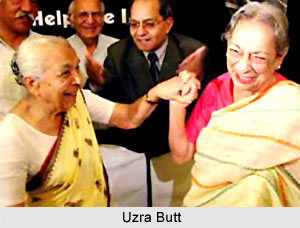 Urza Butt was born on 22nd May in the year of 1917, and was the younger sister of Zohra Sehgal, a Bollywood actress who made a name for herself. She was born in DehraDun, in the state of Uttarakhand. She entered Uday Shankars ballet troupe in Almora as an Indian classical dancer, and also taught dance before joining the Indian People`s Theatre Association (IPTA) in 1944 as an actress.
Urza Butt was born on 22nd May in the year of 1917, and was the younger sister of Zohra Sehgal, a Bollywood actress who made a name for herself. She was born in DehraDun, in the state of Uttarakhand. She entered Uday Shankars ballet troupe in Almora as an Indian classical dancer, and also taught dance before joining the Indian People`s Theatre Association (IPTA) in 1944 as an actress.
Early Life of Urza Butt
Urza Butt was born in a land owning family in the state of Uttar Pradesh in Rampur. She was born as Uzra Mumtaz. She had seven siblings namely Zakullah, Hajrah, Zohra (Zohra Sehgal), Ikramullah, Anna and Sabira, who grew up near Dehra Dun.
Career of Urza Butt
Urza Butt, the popular Hindi theatre personality then worked under Prithviraj Kapoor for Prithvi Theatre till 1960. She played the heroine`s part in Sakuntala in 1944, partnering her sister in Gaddar i.e. `Traitor` in 1948, and taking the lead role in Kisan i.e. `Farmer` in 1956, giving 2500 performances in 1200 towns and cities all over India.
Urza Butt was also art director of Prithvi. In 1964, this Hindi theatre personality migrated to Pakistan, formed a dance troupe in Rawalpindi, acted there on stage and television from time to time, and served the National Council of Arts, Islamabad. She became the leading lady of Ajoka Theatre in Lahore from 1984. Urza Butt reunited with Zohra Segal on stage after forty years in the play Ek thi nani i.e. `There Was a Granny` in 1998. This had a roaring success in Pakistan, India, and also outside India.
Awards Received by Urza Butt
Uzra received the Sangeet Natak Akademi Award for Acting (Urdu) in 1994 by the Sangeet Natak Akademi, India`s National Academy of Music, Dance and Drama. It is the highest Indian recognition given to practicing artists.
Death of Urza Butt
Her last performance on stage was in 2008. She died in Lahore at the age of 93.
This article is a stub. You can enrich by adding more information to it. Send your Write Up to content@indianetzone.com




















